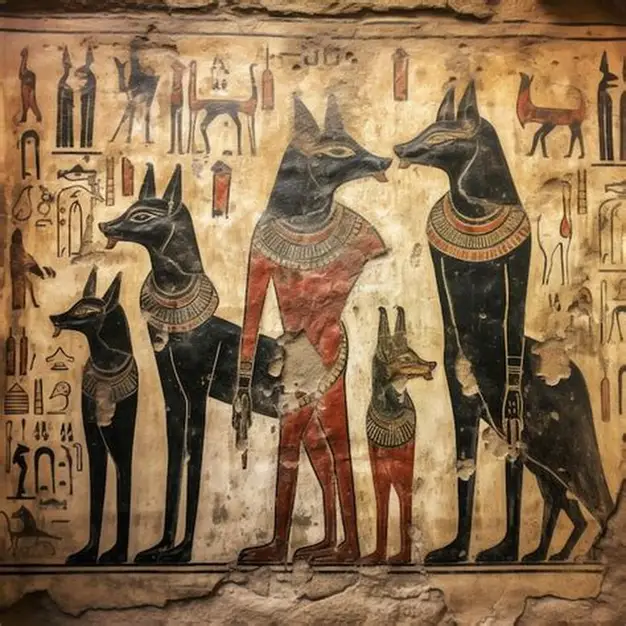Cultural, historical, adventure, and custom customized trips are just a few of the tours that Deluxe trips offer in Egypt and Jordan.

On Deluxe Tours, we welcome you to discover the fascinating role that animals played in ancient Egyptian society, one far more complicated than the one they hold today as cattle or pets—they were tools of the gods, sacred animals, and central figures of religious and social life. Animals were sacred to a fanatically spiritual extent, bridging nature and the divine in a way that inserted itself into every level of Egyptian civilization.
Egyptian cosmology featured a relatively large range of incarnate gods and goddesses in animal form. The falcon, for example, was the god Horus, heavenly guardian, and protector of pharaoh, kingship, and divine order. Cats were under Bastet, house, fertility, and protection goddess, who sometimes appeared either as a cat or woman with a cat's face. Crocodiles were linked to Sobek, the savage god of Nile power and threat. Gods Anubis, Thoth, Wadjet, and Ra were linked with animals such as jackals, ibises, baboons, and cobras, respectively. Even the slaughter of animals such as the lioness represented protection in goddesses such as Sekhmet. This close association with animals also impacted festivals, myth, temple cults, and everyday life, portraying a vision of the world in which religion and nature were closely related.

Deluxe Tours offers tourists a chance to visit ancient animal worship sites. A good example is the cult of the Apis Bull at Memphis The Capital of Ancient Egypt, where a living bull was revered as the living incarnation of the creation god Ptah. The divine bull was indulged in luxurious attention, and upon its death, it was mummified with elaborate ritual and buried in the Serapeum at Saqqara. Bubastis in the Nile Delta was famous for its temple dedicated to Bastet, where thousands dined with troupes of music, dance, and revelry. Divine crocodiles named "Petsuchos" were kept by priests at Crocodilopolis of Faiyum. Others included the ram of Khnum at Elephantine Island and Buchis bull of Montu at Thebes, which were also divine. They lived in temple sanctums, were presented to, and even asked questions of the gods. Killing a sacred beast was blasphemy, proving their divine nature in Egyptian belief.
Possibly the most startling aspect of Egyptian animal cult was the widespread practice of mummification of animals on an immensely large scale. Millions of ibises, cats, falcons, crocodiles, bulls, and other animals were mummified and buried as votive offerings or as temple animals. The temples even had large breeding farms-almost "animal farms"—in an effort to provide pilgrims who purchased mummified animals to be utilized as sacrifices to the deities. Temples such as the Cemetery of Cats at North Saqqara and ibis cemeteries at Tuna el-Gebel show the extent of the practice. Some of the mummified animals received such attention to detail in mummification—crocodiles, for instance, were buried with young wrapped in an attempt to represent regeneration and protection. The treatments demonstrate tremendous Egyptian respect and care for animals even after they have passed on.
Animals were also ubiquitous symbols in Egyptian art and mythology. The celestial battle of order and disorder is Ra's nighttime fight with the monstrous serpent of chaos Apophis, which was the solar god Ra's transformation into a tomcat to defeat Apophis in religious art. It became the symbol of light that vanquished darkness. "The Eye of Ra," which was anthropomorphized as lioness or cobra goddess, was the symbol of celestial protection. Pharaohs who hunted lions and hippopotams, slaying monsters, were more than sporting contests; they symbolized the king's role in delivering unbroken Ma'at—cosmic order and harmony. Recurring motifs, like the ubiquitous New Kingdom depiction of Nebamun bird hunting with his cat, carried religious meaning, depicting animals' protective power and symbolic meaning.
The most typical feature of ancient Egyptian religion was the abundance of hybrid gods—gods with the head of a man and an animal, or animals with the head of a man. This grotesque art summarized divine virtues and powers in a nutshell. The god Anubis, god of guarding and mummification, was a jackal-headed man, and so he protected the necropolis. Thoth, god of writing and wisdom, was ibis-headed or baboon-headed man, a symbol of his intellectual and celestial endeavors. Sekhmet was lioness-headed goddess, a symbol of protective rage. Horus was falcon-headed man, the union of royal man with the acute vision and swiftness of the falcon. Sobek, crocodile-headed man, was replete with fertility and strength. These forms were not found unusual by Egyptians but instead as natural, visible expressions of divine substance. Cosmic order and celestial justice were represented by mythological hybrid creatures like Ammit—crocodile, lion, and hippopotamus blended together. These symbolic animals decorated temples, tombs, and religious writings, reminding all of the strong interdependencies that existed between animals, man, and gods.

Apart from their symbolic and religious functions, animals were a staple of Egypt's economy and daily existence. Agriculture, which was the basis of Egyptian prosperity, also depended on domesticated animals like sheep, goats, and oxen for labor, sustenance, and material. Oxen broke up the heavy Nile mud after the flood and revolutionized agriculture. Cattle provided beef, milk, hides, and dung used for fuel as well as fertilizer. Animals were property, and tomb decoration would typically illustrate farmers cultivating herds with soft hands, showing the affection and fondness accorded to herds. Bulls were esteemed because of their virility and masculinity, both for utilitarian activities as well as ritual activities like sports and bull hunting, demonstrating economic usefulness and symbolic status.
In short, ancient Egyptian animals were far more than simple animals. They were symbolic gods, god personifications living in the flesh, and pillars of economy, myth, and religion. From the royal falcon of Horus to the bull of divine meaning, animals occupied the middle ground between the human and the divine, and they defined the strange form of Egyptian civilization. Deluxe Tours promises to see it for yourself, traveling to temples, tombs, and museums that pay homage to Egypt's incredible animal heritage. Visit and sense the powerful connection the ancient Egyptians shared with the animal kingdom—a connection that characterized one of the greatest civilizations the world has ever known.
Discover now our answers to the most common questions that may come to your mind about tourism and trips to Egypt
Cultural, historical, adventure, and custom customized trips are just a few of the tours that Deluxe trips offer in Egypt and Jordan.
The Dead Sea, Petra in Jordan, the Pyramids of Giza, Luxor's historic temples, and many other famous sites can be expected to be explored with Deluxe Tours.
offer a hassle-free holiday, Deluxe Tours' packages generally include lodging, transport, meals, guided tours with experienced local experts, and entry fees to attractions.
Spring (March to May) and fall (September to November) offer the finest weather for sightseeing and outdoor activities, making those months the best times to visit Egypt and Jordan.
These two countries are close by, only a 1.5-hour flight apart, and when combined, offer a variety of distinctive experiences. We advise you to spend at least 12 days visiting both countries for a truly unforgettable experience
Combining the eclipse viewing with visits to historic sites like the Pyramids of Giza, the Valley of the Kings, and a Nile River cruise are highly recommended.
